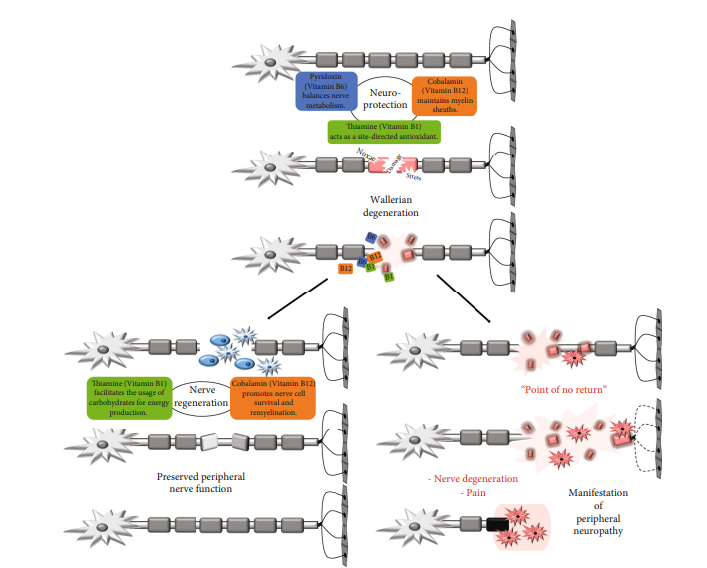Scientists are not sure exactly what causes diabetic neuropathy. One thought is that high blood sugar levels and glucose damage the capillaries that supply oxygen and nutrients to nerve fibers.
Paradoxically, medications often prescribed to manage diabetes can worsen neuropathy due to drug-induced nutrient depletion (DIND). This extends beyond diabetes medications to include those prescribed for the treatment of high blood pressure. Statistics from the Centers for Disease Control and Prevention (CDC) and National Health and Nutritional Examination Survey (NHANES) database show that 73.6% of individuals with diabetes aged 18 years or older also have hypertension.
Diabetes and Peripheral Neuropathy
Peripheral neuropathy is a type of nerve damage that typically affects the feet and legs and sometimes affects the hands and arms. This type of neuropathy is unfortunately very common. About one-third to one-half of people with diabetes have peripheral neuropathy.
It’s important to understand that diabetic neuropathy is more than just uncomfortable for your patients. It can reduce their quality of life, lead them to become more sedentary and result in serious complications.
Common symptoms of neuropathy may include:
- Numbness or reduced ability to feel pain or temperature changes
- Tingling or burning feeling
- Sharp pains or cramps
- Muscle weakness
- Extreme sensitivity to touch—for some people, even a bedsheet’s weight can be painful
- Serious foot problems, such as ulcers, infections, or bone and joint damage

Image Source: Baltrusch S. The Role of Neurotropic B Vitamins in Nerve Regeneration. Biomed Res Int. 2021;2021:9968228.
Neuropathy Associated with Drug-Induced Nutrient Depletion
Some of the most popular drugs used for high blood pressure and diabetes treatment can deplete important nutrients the body needs to help rebuild nerve tissue. These drugs and the resultant DIND can exacerbate neuropathy.
Common Diabetes Medications
- Biguanides (metformin): Deplete folic acid and vitamin B12, which are needed for nerve cell formation
- Sulfonylureas (glyburide, glipizide and glimepiride): Deplete coenzyme Q10, which is needed for nerve function
Common High Blood Pressure Medications
- ACE inhibitors (lisinopril): Deplete zinc, which is needed for nerve cell formation, can increase blood flow to nerve cells and help block nerve pain
- Diuretics (furosemide): Deplete magnesium, phosphorus, potassium, zinc, coenzyme Q10, and vitamins B1 and B6, all of which can help with nerve cell production or proper nerve transmission
- Statin drugs (atorvastatin): Deplete coenzyme Q10, which is needed for nerve function
Nutrients That Support Nerve Health
Keeping the above list in mind, you can use the following nutrients to help prevent or reverse DIND and support healthy nerve function:
- B-complex vitamins (once daily)
- Coenzyme Q10 (100-300 mg daily)
- Multivitamin (twice daily)
- Will replace B vitamins and other vital minerals
- Use professional-grade multivitamins for greater efficacy
- EPA/DHA fish oil (minimum 600-800 mg of active ingredients per capsule)
- Essential building blocks for certain nerve cells
- Alpha lipoic acid (ALA) (600 mg capsule twice daily)
- Studies show ALA helps to rebuild parts of nerve cells and lessens pain and numbness
I recommend patients follow the above regimen for at least six months because nerve tissue is slow to respond.
Lifestyle Choices That Support Nerve Health
The following lifestyle modifications may be more challenging than following a supplement regimen, but working to achieve them will support your patients’ nerve health and improve their quality of life.
- Eat a modified Mediterranean diet that is high in vegetables and contains a moderate amount of lean meats
- Exercise three to five times per week
- Quit smoking
- Minimize alcohol intake
- Maintain a healthy body weight
The Bottom Line
Be aware that many of the top 200 drugs can deplete the body’s essential nutrients. When reviewing a patient’s list of medications, consider how new or worsening symptoms may be due in part to DIND. And as always, good luck through good nutrition!

Jeff Robins, RPh has been a compounding pharmacist for 25 years and likes to speak of himself as the pharmacist who dislikes drugs. Jeff owned the remarkably successful Essential Wellness Pharmacy where he grew the annual sales of supplements to over $1.1 million. Jeff is an Advanced Fellow with the American College of Anti-Aging and Functional Medicine through the University of Southern Florida, and he is the owner of Summit Functional Consulting. He is passionate about educating people and giving them a chance to make informed decisions about their health and healthcare.
References
- Sharp L. Diabetic polyneuropathy. In: Ferri's Clinical Advisor 2022. Elsevier;2020. https://www.clinicalkey.com.
- Jankovic J, et al., eds. Disorders of peripheral nerves. In: Bradley and Daroff's Neurology in Clinical Practice. 8th ed. Elsevier;2022. https://www.clinicalkey.com.
- Centers for Disease Control and Prevention. National Diabetes Statistics Report. U.S. Dept of Health and Human Services. 2020.
- Diabetic neuropathy. National Institute of Diabetes and Digestive and Kidney Diseases. https://www.niddk.nih.gov/health-information/diabetes/overview/preventing-problems/nerve-damage-diabetic-neuropathies/all-content.
- American Diabetes Association. Standards of medical care in diabetes—2021. Diabetes Care. 2021. https://care.diabetesjournals.org/content/44/Supplement_1
- Baute V, Zelnik D, Curtis J, Sadeghifar F. Complementary and Alternative Medicine for Painful Peripheral Neuropathy. Curr Treat Options Neurol. 2019;21(9):44. Published 2019 Sep 2. doi:10.1007/s11940-019-0584-z
- Ting RZ, Szeto CC, Chan MH, Ma KK, Chow KM. Risk factors of vitamin B(12) deficiency in patients receiving metformin. Arch Intern Med. 2006;166(18):1975-1979. doi:10.1001/archinte.166.18.1975
- Wulffele MG, Kooy A, Lehert P, et al. Effects of short-term treatment with metformin on serum concentrations of homocysteine, folate and vitamin B12 in type 2 diabetes mellitus: A randomized, placebo-controlled trial. J Intern Med. 2003;254:455-463.
- Golik A, Zaidenstein R, Dishi V, et al. Effects of captopril and enalapril on zinc metabolism in hypertensive patients. J Am Coll Nutr. 1998;17(1):75-78. doi:10.1080/07315724.1998.10720459
- Nathan DM, Buse JB, Davidson MB, et al. Medical management of hyperglycemia in type 2 diabetes: a consensus algorithm for the initiation and adjustment of therapy: a consensus statement of the American Diabetes Association and the European Association for the Study of Diabetes. Diabetes Care. 2009;32(1):193-203. doi:10.2337/dc08-9025
- Caspary WF, Zavada I, Reimold W, et al. Alteration of bile acid metabolism and vitamin-B12-absorption in diabetics on biguanides. Diabetologia. 1977;13:187–193.
- Schäfer G. Some new aspects on the interaction of hypoglycemia-producing biguanides with biological membranes. Biochem Pharmacol. 1976;25:2014–2024.
- Bauman WA, Shaw S, Jayatilleke E, et al. Increased intake of calcium reverses vitamin B12 malabsorption induced by metformin. Diabetes Care. 2000;23:1227–1231.
- Eriksson JG, Forsen TJ, Mortensen SA, Rohde M. The effect of coenzyme Q10 administration on metabolic control in patients with type 2 diabetes mellitus. Biofactors. 1999;9(2-4):315-318.
- Folkers K, Morita M, McRee J Jr. The activities of coenzyme Q10 and vitamin B6 for immune responses. Biochem Biophys Res Commun. 1993; 28(19391):88-92.
- Bailey CJ, Wilcock C, Scarpello JH. Metformin and the intestine. Diabetologia. 2008;51:1552–1553.
- Pelton R, LaValle J. The Nutritional Cost of Drugs. Morton Publishing. 2004.
- Pelton R, Lavalle J, Hawkins E, Krinsky D. Drug-Induced Nutrient Depletion Handbook. Lexi-Comp Inc. 2001.
- Tomkin GH. Malabsorption of vitamin B12 in diabetic patients treated with phenformin: a comparison with metformin. Br Med J. 1973;3:673–675.
- Chreifi G, Li H, McInnes CR, Gibson CL, Suckling CJ, Poulos TL. Communication between the zinc and tetrahydrobiopterin binding sites in nitric oxide synthase. Biochemistry. 2014;53(25):4216-4223. doi:10.1021/bi5003986
- Bünning P, Riordan JF. The functional role of zinc in angiotensin converting enzyme: implications for the enzyme mechanism. J Inorg Biochem. 1985;24(3):183-198. doi:10.1016/0162-0134(85)85002-9
- Luo J, Bavencoffe A, Yang P, et al. Zinc Inhibits TRPV1 to Alleviate Chemotherapy-Induced Neuropathic Pain. J Neurosci. 2018;38(2):474-483. doi:10.1523/JNEUROSCI.1816-17.2017
- Alcázar-Fabra M, Trevisson E, Brea-Calvo G. Clinical syndromes associated with Coenzyme Q10 deficiency. Essays Biochem. 2018;62(3):377-398. Published 2018 Jul 20. doi:10.1042/EBC20170107
- Attia HN, Maklad YA. Neuroprotective effects of coenzyme Q10 on paraquat-induced Parkinson's disease in experimental animals. Behav Pharmacol. 2018;29(1):79-86. doi:10.1097/FBP.0000000000000342



